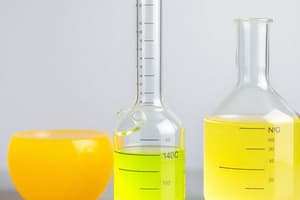Podcast
Questions and Answers
Which of the following statements accurately describes the behavior of acids based on the Brnsted-Lowry definition?
Which of the following statements accurately describes the behavior of acids based on the Brnsted-Lowry definition?
- Acids donate electron pairs to form covalent bonds.
- Acids produce hydroxide ions (OH) in aqueous solutions.
- Acids accept electron pairs to form covalent bonds.
- Acids donate protons (H) to other substances. (correct)
In a laboratory setting, a student observes that a solution turns red litmus paper blue and feels slippery to the touch. According to the characteristic properties of acids and bases, how should the solution be classified?
In a laboratory setting, a student observes that a solution turns red litmus paper blue and feels slippery to the touch. According to the characteristic properties of acids and bases, how should the solution be classified?
- Strongly basic (correct)
- Strongly acidic
- Weakly basic
- Weakly acidic
Consider two solutions: Solution A has a pH of 3, and Solution B has a pH of 5. Which statement correctly compares the hydrogen ion concentrations of the two solutions?
Consider two solutions: Solution A has a pH of 3, and Solution B has a pH of 5. Which statement correctly compares the hydrogen ion concentrations of the two solutions?
- Solution A has 2 times higher hydrogen ion concentration than Solution B.
- Solution A has 10 times higher hydrogen ion concentration than Solution B.
- Solution B has 100 times higher hydrogen ion concentration than Solution A.
- Solution A has 100 times higher hydrogen ion concentration than Solution B. (correct)
Which of the following scenarios accurately demonstrates the process of neutralization?
Which of the following scenarios accurately demonstrates the process of neutralization?
During a titration experiment, a student adds 25.0 mL of a 0.1 M NaOH solution to 20.0 mL of an HCl solution with unknown concentration. At the equivalence point, the reaction is complete. What is the molarity of the HCl solution?
During a titration experiment, a student adds 25.0 mL of a 0.1 M NaOH solution to 20.0 mL of an HCl solution with unknown concentration. At the equivalence point, the reaction is complete. What is the molarity of the HCl solution?
A solution has a hydroxide ion concentration of $1.0 imes 10^{-5}$ M. What is the pOH of this solution?
A solution has a hydroxide ion concentration of $1.0 imes 10^{-5}$ M. What is the pOH of this solution?
If the pH of a solution is 9, what is the hydrogen ion concentration [H+]?
If the pH of a solution is 9, what is the hydrogen ion concentration [H+]?
Which of the following correctly ranks the acids in order of increasing strength, given their (K_a) values: Acid A ((K_a = 1.8 imes 10^{-5})), Acid B ((K_a = 3.5 imes 10^{-8})), Acid C ((K_a = 2.9 imes 10^{-2}))?
Which of the following correctly ranks the acids in order of increasing strength, given their (K_a) values: Acid A ((K_a = 1.8 imes 10^{-5})), Acid B ((K_a = 3.5 imes 10^{-8})), Acid C ((K_a = 2.9 imes 10^{-2}))?
In aqueous solution, which of the following weak acids will have the lowest pH, given equal concentrations?
In aqueous solution, which of the following weak acids will have the lowest pH, given equal concentrations?
Which statement correctly describes what happens when a strong acid is added to water?
Which statement correctly describes what happens when a strong acid is added to water?
A chemist prepares a solution of ammonia (NH) in water. Which of the following describes the role of ammonia in this solution, according to the Brnsted-Lowry definition?
A chemist prepares a solution of ammonia (NH) in water. Which of the following describes the role of ammonia in this solution, according to the Brnsted-Lowry definition?
A solution of acetic acid ($CH_3COOH$) has a concentration of 0.1 M. Given that its (K_a) is $1.8 imes 10^{-5}$, which expression correctly represents the equilibrium for the dissociation of acetic acid in water?
A solution of acetic acid ($CH_3COOH$) has a concentration of 0.1 M. Given that its (K_a) is $1.8 imes 10^{-5}$, which expression correctly represents the equilibrium for the dissociation of acetic acid in water?
Which of the following is a property of acids according to the Arrhenius definition?
Which of the following is a property of acids according to the Arrhenius definition?
Which of the following statements accurately describes the relationship between pH and pOH in aqueous solutions at 25C?
Which of the following statements accurately describes the relationship between pH and pOH in aqueous solutions at 25C?
During a titration, 30.0 mL of 0.2 M HCl is required to neutralize 25.0 mL of a base solution. What is the molarity of the base?
During a titration, 30.0 mL of 0.2 M HCl is required to neutralize 25.0 mL of a base solution. What is the molarity of the base?
Flashcards
Properties of Acids
Properties of Acids
Taste sour, turn blue litmus paper red, react with metals to produce hydrogen gas, conduct electricity in solution, and donate H⁺ ions.
Properties of Bases
Properties of Bases
Taste bitter, feel slippery, turn red litmus paper blue, conduct electricity, and accept H⁺ ions.
Arrhenius definition of acids and bases
Arrhenius definition of acids and bases
Acids produce H⁺ ions in solution, while bases produce OH⁻ ions in solution.
Brønsted-Lowry definition of acids and bases
Brønsted-Lowry definition of acids and bases
Signup and view all the flashcards
Lewis definition of acids and bases
Lewis definition of acids and bases
Signup and view all the flashcards
Strong Acids/Bases
Strong Acids/Bases
Signup and view all the flashcards
Weak Acids/Bases
Weak Acids/Bases
Signup and view all the flashcards
Acid Dissociation Constant (Ka)
Acid Dissociation Constant (Ka)
Signup and view all the flashcards
Base Dissociation Constant (Kb)
Base Dissociation Constant (Kb)
Signup and view all the flashcards
pH
pH
Signup and view all the flashcards
pOH
pOH
Signup and view all the flashcards
Acidic solution
Acidic solution
Signup and view all the flashcards
Neutral solution
Neutral solution
Signup and view all the flashcards
Basic solution
Basic solution
Signup and view all the flashcards
Neutralization Reaction
Neutralization Reaction
Signup and view all the flashcards
Study Notes
- Acids and bases are fundamental chemical concepts
Properties of Acids:
- Acids taste sour
- Acids turn blue litmus paper red
- Acids react with metals to produce hydrogen gas
- Acids conduct electricity in solution
- Acids donate H⁺ ions, according to the Arrhenius & Brønsted-Lowry definitions
Properties of Bases:
- Bases taste bitter
- Bases feel slippery
- Bases turn red litmus paper blue
- Bases conduct electricity in solution
- Bases accept H⁺ ions, according to the Brønsted-Lowry definition
Acid-Base Theories:
- Arrhenius Definition: Acids produce H⁺ ions in solution, while bases produce OH⁻ ions in solution
- Brønsted-Lowry Definition: Acids are proton (H⁺) donors, whereas bases are proton (H⁺) acceptors
- Lewis Definition: Acids accept an electron pair, while bases donate an electron pair
Common Acids & Bases:
- Hydrochloric Acid (HCl) is a common acid
- Sulfuric Acid (H₂SO₄) is a common acid
- Nitric Acid (HNO₃) is a common acid
- Acetic Acid (CH₃COOH) is a common acid
- Sodium Hydroxide (NaOH) is a common base
- Potassium Hydroxide (KOH) is a common base
- Ammonia (NH₃) is a common base
- Calcium Hydroxide (Ca(OH)₂) is a common base
Strengths of Acids and Bases:
- Strong acids completely ionize in water (e.g., HCl, HNO₃, H₂SO₄)
- Weak acids only partially ionize (e.g., CH₃COOH)
- Strong bases completely dissociate in water (e.g., NaOH, KOH)
- Weak bases only partially dissociate (e.g., NH₃)
Dissociation Equations:
- Strong Acid: ( HCl \rightarrow H^+ + Cl^- )
- Weak Acid: ( CH_3COOH \rightleftharpoons H^+ + CH_3COO^- )
- Strong Base: ( NaOH \rightarrow Na^+ + OH^- )
- Weak Base: ( NH_3 + H_2O \rightleftharpoons NH_4^+ + OH^- )
Equilibrium Constant (Ka and Kb):
- A large ( K_a ) indicates a stronger acid
- A large ( K_b ) indicates a stronger base
Problem-Solving for Weak Acids:
- To find the dissociation constant: ( K_a = \frac{[H^+][A^-]}{[HA]} )
- Steps to calculate the pH of a weak acid:
- Write the dissociation equation
- Use an ICE table (Initial, Change, Equilibrium)
- Solve for H⁺ concentration using Ka
- Calculate pH using ( pH = -\log[H^+] )
pH & pOH Scale:
- pH measures H⁺ concentration: ( pH = -\log [H^+] )
- pOH measures OH⁻ concentration: ( pOH = -\log [OH^-] )
- Relationship between pH and pOH: ( pH + pOH = 14 )
Neutral, Acidic, and Basic Solutions:
- Acidic solutions have a pH < 7
- Neutral solutions have a pH = 7
- Basic solutions have a pH > 7
Ion Product Constant for Water:
- ( K_w = [H^+][OH^-] = 1.0 \times 10^{-14} )
Problem-Solving with pH and pOH:
- To find pH given H⁺ concentration: ( pH = -\log(1.0 \times 10^{-3}) = 3 ) if ([H^+] = 1.0 \times 10^{-3})
- To find pOH given OH⁻ concentration: ( pOH = -\log(2.0 \times 10^{-5}) \approx 4.7 ) if ([OH^-] = 2.0 \times 10^{-5})
- To find H⁺ or OH⁻ given pH or pOH:
- ([H^+] = 10^{-pH})
- ([OH^-] = 10^{-pOH})
Neutralization Reaction:
- Acid + Base → Salt + Water
- Example: ( HCl + NaOH \rightarrow NaCl + H_2O )
Titration:
- Titration is used to determine an unknown concentration
- Titration uses a burette to add a base to an acid (or vice versa)
- Equivalence Point: Moles of ( H^+ ) = Moles of ( OH^- )
Titration Formula:
- ( M_a V_a = M_b V_b )
- ( M_a ) = molarity of acid
- ( V_a ) = volume of acid
- ( M_b ) = molarity of base
- ( V_b ) = volume of base
Studying That Suits You
Use AI to generate personalized quizzes and flashcards to suit your learning preferences.




